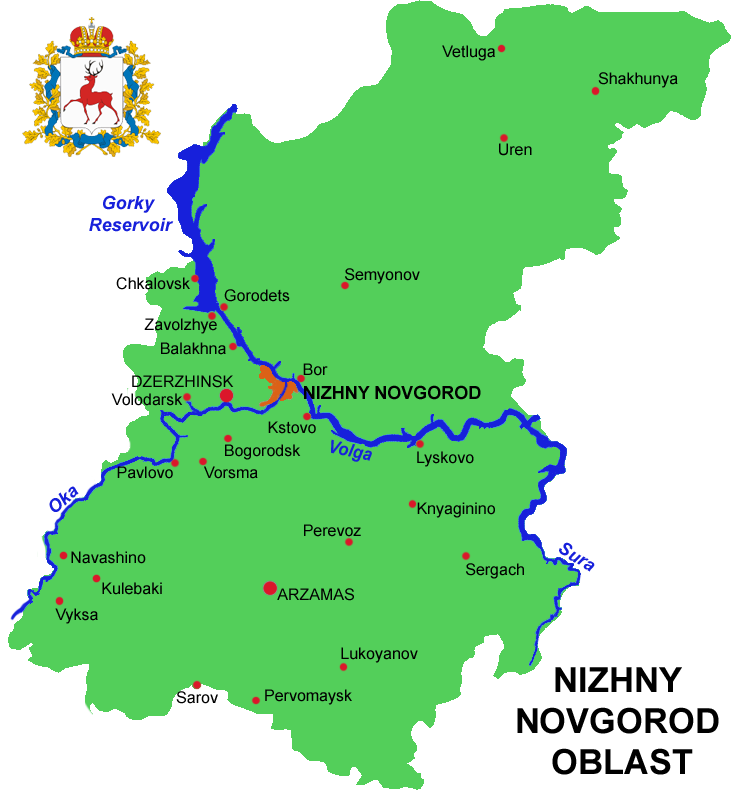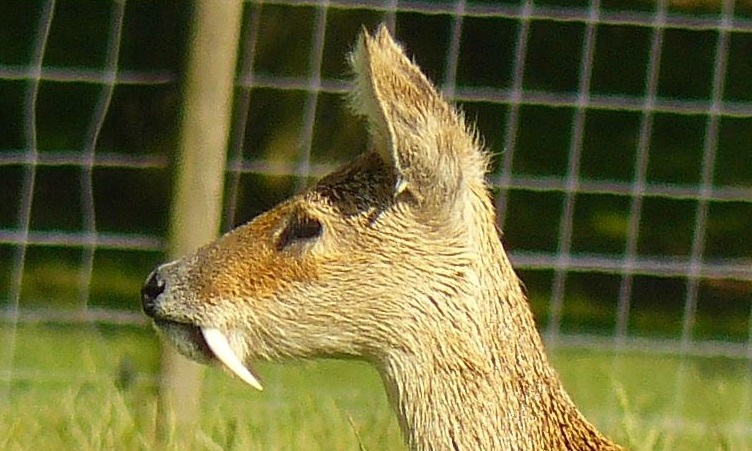|
Purlovia
''Purlovia'' is an extinct genus of herbivorous therocephalian therapsids from the Late Permian of Russia. Together with the closely related South African genus '' Nanictidops'', it is a member of the family Nanictidopidae. Fossils have been found from the Tonshayevsky District of Nizhny Novgorod Oblast. The type species In zoological nomenclature, a type species (''species typica'') is the species name with which the name of a genus or subgenus is considered to be permanently taxonomically associated, i.e., the species that contains the biological type specimen ... of ''Purlovia'', ''P. maxima'', was named in 2011. In comparison to other therocephalians, ''Purlovia'' has a very wide skull due to a widened temporal region. Viewed from above, it looks roughly triangular. The skull is about long, with nearly half its length in the postorbital region behind the eye sockets. It has large canine teeth and smaller buccal, or cheek teeth, along the thick upper and lower jaws. The ... [...More Info...] [...Related Items...] OR: [Wikipedia] [Google] [Baidu] |
Nanictidopidae
Nanictidopidae is an extinct family of therocephalian therapsids from the Late Permian. Two genera are currently included in the family, '' Nanictidops'' from South Africa and ''Purlovia'' from Russia. Nanictidopids have short skulls and were probably herbivorous. Description In comparison to other therocephalians, nanictidopids are relatively large, with skulls ranging from in length. Nanictidopids are characterized by their shortened skulls that appear triangular when viewed from above. The temporal region of the skull is very wide. Their skulls are similar to those of hofmeyriids, and the superfamily Nanictidopoidea has been established to unite these two groups. Nanictidopids have enlarged canine teeth in their upper and lower jaws, while the teeth behind them are very small. Small bumps and ridges cover parts of the upper and lower jaws. The parietal region at the back of the skull forms a sagittal crest. The postorbital bones that make up the back of the eye sockets are ver ... [...More Info...] [...Related Items...] OR: [Wikipedia] [Google] [Baidu] |
2011 In Paleontology
Protozoa New taxa Plants Ferns and fern allies Gymnosperms Gymnosperm research *An amplified whole plant reconstruction of the Ypresian Princeton chert pine ''Pinus arnoldii'', expanding the diagnosis to include ''P. similkameenensis'' (Miller, 1973 Events January * January 1 - The United Kingdom, the Republic of Ireland and Denmark 1973 enlargement of the European Communities, enter the European Economic Community, which later becomes the European Union. * January 15 – Vietnam War: ...) foliage and wood plus unnamed pollens cones found in attachment to the ''P. arnoldii'' ovulate cones is published by Klymiuk, Stockey, & Rothwell. Angiosperms Nematoda Lobopods Vetulicolians Molluscs Arthropods Fishes Amphibians Newly named lepospondyls Newly named temnospondyls Newly named lissamphibians Basal reptiles Newly named captorhinids Newly named basal diapsids Newly named ichthyosaurs Lepidosauromorphs Newly named saurosphargids Newly ... [...More Info...] [...Related Items...] OR: [Wikipedia] [Google] [Baidu] |
Late Permian
Late may refer to: * LATE, an acronym which could stand for: ** Limbic-predominant age-related TDP-43 encephalopathy, a proposed form of dementia ** Local-authority trading enterprise, a New Zealand business law ** Local average treatment effect, a concept in econometrics Music * ''Late'' (album), a 2000 album by The 77s * Late!, a pseudonym used by Dave Grohl on his ''Pocketwatch'' album * Late (rapper), an underground rapper from Wolverhampton * "Late" (song), a song by Blue Angel * "Late", a song by Kanye West from ''Late Registration'' Other * Late (Tonga), an uninhabited volcanic island southwest of Vavau in the kingdom of Tonga * "Late" (''The Handmaid's Tale''), a television episode * LaTe, Oy Laivateollisuus Ab, a defunct shipbuilding company * Late may refer to a person who is Dead See also * * * ''Lates'', a genus of fish in the lates perch family * Later (other) * Tardiness * Tardiness (scheduling) In scheduling, tardiness is a measure of a delay in exe ... [...More Info...] [...Related Items...] OR: [Wikipedia] [Google] [Baidu] |
Therocephalia
Therocephalia is an extinct suborder of eutheriodont therapsids (mammals and their close relatives) from the Permian and Triassic. The therocephalians ("beast-heads") are named after their large skulls, which, along with the structure of their teeth, suggest that they were carnivores. Like other non-mammalian synapsids, therocephalians were once described as " mammal-like reptiles". Therocephalia is the group most closely related to the cynodonts, which gave rise to the mammals. This relationship takes evidence in a variety of skeletal features. The fossils of therocephalians are numerous in the Karoo of South Africa, but have also been found in Russia, China, Tanzania, Zambia, and Antarctica. Early therocephalian fossils discovered in Middle Permian deposits of South Africa support a Gondwanan origin for the group, which seems to have spread quickly across Earth. Although almost every therocephalian lineage ended during the great Permian–Triassic extinction event, a few re ... [...More Info...] [...Related Items...] OR: [Wikipedia] [Google] [Baidu] |
Therapsid
Therapsida is a major group of eupelycosaurian synapsids that includes mammals, their ancestors and relatives. Many of the traits today seen as unique to mammals had their origin within early therapsids, including limbs that were oriented more underneath the body, as opposed to the sprawling posture of many reptiles and salamanders. Therapsids evolved from " pelycosaurs", specifically within the Sphenacodontia, more than 279.5 million years ago. They replaced the "pelycosaurs" as the dominant large land animals in the Middle Permian through to the Early Triassic. In the aftermath of the Permian–Triassic extinction event, therapsids declined in relative importance to the rapidly diversifying reptiles during the Middle Triassic. The therapsids include the cynodonts, the group that gave rise to mammals ( Mammaliaformes) in the Late Triassic, around 225 million years ago. Of the non-mammalian therapsids, only cynodonts survived beyond the end of the Triassic, with the only ot ... [...More Info...] [...Related Items...] OR: [Wikipedia] [Google] [Baidu] |
Russia
Russia (, , ), or the Russian Federation, is a transcontinental country spanning Eastern Europe and Northern Asia. It is the largest country in the world, with its internationally recognised territory covering , and encompassing one-eighth of Earth's inhabitable landmass. Russia extends across eleven time zones and shares land boundaries with fourteen countries, more than any other country but China. It is the world's ninth-most populous country and Europe's most populous country, with a population of 146 million people. The country's capital and largest city is Moscow, the largest city entirely within Europe. Saint Petersburg is Russia's cultural centre and second-largest city. Other major urban areas include Novosibirsk, Yekaterinburg, Nizhny Novgorod, and Kazan. The East Slavs emerged as a recognisable group in Europe between the 3rd and 8th centuries CE. Kievan Rus' arose as a state in the 9th century, and in 988, it adopted Orthodox Christianity from the ... [...More Info...] [...Related Items...] OR: [Wikipedia] [Google] [Baidu] |
South Africa
South Africa, officially the Republic of South Africa (RSA), is the southernmost country in Africa. It is bounded to the south by of coastline that stretch along the South Atlantic and Indian Oceans; to the north by the neighbouring countries of Namibia, Botswana, and Zimbabwe; and to the east and northeast by Mozambique and Eswatini. It also completely enclaves the country Lesotho. It is the southernmost country on the mainland of the Old World, and the second-most populous country located entirely south of the equator, after Tanzania. South Africa is a biodiversity hotspot, with unique biomes, plant and animal life. With over 60 million people, the country is the world's 24th-most populous nation and covers an area of . South Africa has three capital cities, with the executive, judicial and legislative branches of government based in Pretoria, Bloemfontein, and Cape Town respectively. The largest city is Johannesburg. About 80% of the population are Black Sou ... [...More Info...] [...Related Items...] OR: [Wikipedia] [Google] [Baidu] |
Tonshayevsky District
Tonshayevsky District (russian: Тонша́евский райо́н) is an administrative district (raion), one of the forty in Nizhny Novgorod Oblast, Russia.Order #3-od Municipally, it is incorporated as Tonshayevsky Municipal District.Resolution #670 It is located in the northeast of the oblast. The area of the district is . Its administrative center is the urban locality (a work settlement) of Tonshayevo. Population: 20,219 ( 2010 Census); The population of Tonshayevo accounts for 22.6% of the district's total population. History The district was established in 1929. Transportation The Altsevo peat narrow gauge railway is located in the work settlement of Pizhma, closed in 2015. The Pizhemskaya narrow gauge railway The Pizhemskaya narrow gauge railway (''russian: link=no, Пижменская узкоколейная железная дорога, Pizhemskaya uzkokoleynaya zheleznaya doroga'') is a narrow-gauge railway in Nizhny Novgorod Oblast, Russia, buil ... is l ... [...More Info...] [...Related Items...] OR: [Wikipedia] [Google] [Baidu] |
Nizhny Novgorod Oblast
Nizhny Novgorod Oblast (russian: link=no, Нижегородская область, ''Nizhegorodskaya oblast''), is a federal subject of Russia (an oblast). Its administrative center is the city of Nizhny Novgorod. It has a population of 3,310,597 as of the 2010 Census. From 1932 to 1990 it was known as Gorky Oblast. The oblast is crossed by the Volga River. Apart from Nizhny Novgorod's metropolitan area (including Dzerzhinsk, Bor and Kstovo) the biggest city is Arzamas. Near the town of Sarov there is the Serafimo-Diveyevsky Monastery, one of the largest convents in Russia, established by Saint Seraphim of Sarov. The Makaryev Monastery opposite of the town of Lyskovo used to be the location of the largest fair in Eastern Europe. Other historic towns include Gorodets and Balakhna, located on the Volga to the north from Nizhny Novgorod. Geography The oblast covers an area of , which is approximately equal to the entire area of the Benelux countries or Czech Republ ... [...More Info...] [...Related Items...] OR: [Wikipedia] [Google] [Baidu] |
Type Species
In zoological nomenclature, a type species (''species typica'') is the species name with which the name of a genus or subgenus is considered to be permanently taxonomically associated, i.e., the species that contains the biological type specimen(s). Article 67.1 A similar concept is used for suprageneric groups and called a type genus. In botanical nomenclature, these terms have no formal standing under the code of nomenclature, but are sometimes borrowed from zoological nomenclature. In botany, the type of a genus name is a specimen (or, rarely, an illustration) which is also the type of a species name. The species name that has that type can also be referred to as the type of the genus name. Names of genus and family ranks, the various subdivisions of those ranks, and some higher-rank names based on genus names, have such types. [...More Info...] [...Related Items...] OR: [Wikipedia] [Google] [Baidu] |
Canine Teeth
In mammalian oral anatomy, the canine teeth, also called cuspids, dog teeth, or (in the context of the upper jaw) fangs, eye teeth, vampire teeth, or vampire fangs, are the relatively long, pointed teeth. They can appear more flattened however, causing them to resemble incisors and leading them to be called ''incisiform''. They developed and are used primarily for firmly holding food in order to tear it apart, and occasionally as weapons. They are often the largest teeth in a mammal's mouth. Individuals of most species that develop them normally have four, two in the upper jaw and two in the lower, separated within each jaw by incisors; humans and dogs are examples. In most species, canines are the anterior-most teeth in the maxilla The maxilla (plural: ''maxillae'' ) in vertebrates is the upper fixed (not fixed in Neopterygii) bone of the jaw formed from the fusion of two maxillary bones. In humans, the upper jaw includes the hard palate in the front of the mouth. The ... [...More Info...] [...Related Items...] OR: [Wikipedia] [Google] [Baidu] |




_(2).jpg)
